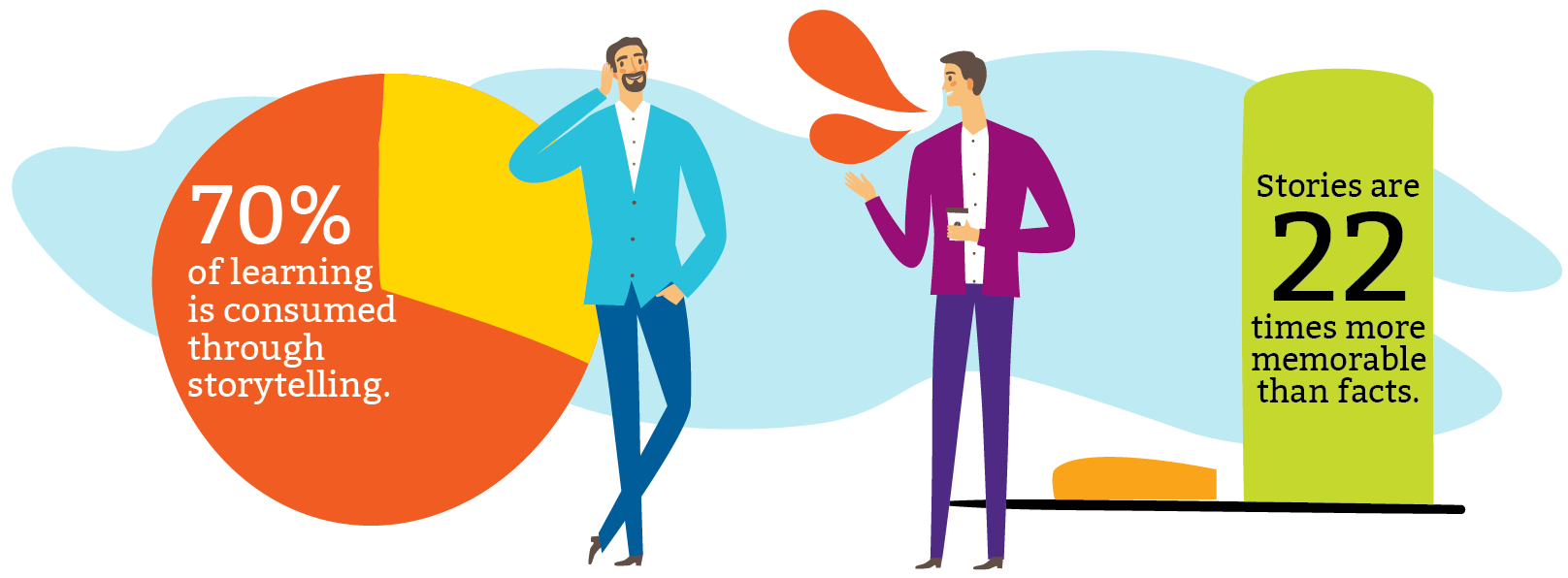7 STEPS TO TELLING STELLAR STORIES
Storytelling dates back to the earliest days of humanity – think cave wall paintings, think Epic of Gilgamesh or Instructions of Shuruppak. (You know Shuruppak, right? Okay. Never mind.) Stories are powerful; they teach new ideas, entertain, challenge our thinking, create connections, and paint pictures in our minds. A stellar story brings you to tears, makes you laugh out loud, is passed down through generations, or and can go viral in a matter of minutes.

Professor Allan Fels, AO and former dean of the Australia and New Zealand School of Government, found that 70 percent of what we learn is consumed through storytelling. Jennifer Aaker, a professor of marketing at Stanford’s Graduate School of Business, notes that stories are 22 times more memorable than facts alone.
Yet, despite the well-documented power of storytelling, many leaders and organizations are awful at telling stories that connect people to the things they should care about in their jobs.
“Stories constitute the single most powerful weapon in a leader’s arsenal.”
— Dr. Howard Gardner, professor, Harvard University

SEVEN WAYS TO BECOME A STELLAR STORYTELLER RIGHT NOW
 GO BEYOND THE FINANCIALS.
GO BEYOND THE FINANCIALS.
Leaders love numbers. But charts and graphs full of data, percentages, and revenue summaries don’t motivate people. Of course, your business can’t be successful without creating sustainable, profitable growth, and people want to work for a business that’s in the black. But if their paychecks aren’t increasing as revenue does, then the bottom line story isn’t enough. Think beyond the numbers and focus on what really motivates and inspires your people.

 AVOID SLOGANS AND ACRONYMS.
AVOID SLOGANS AND ACRONYMS.
ROI, PDQ, LOL, EBITDA. “Make a difference.” “Take the leap.” “Be the change.” Snooze. Fest. How many of the speeches and presentations you hear (or give?) make people want to print out Buzzword Bingo sheets? Painful. Choose your words carefully, be relatable, be authentic, be you. A great way to start is with a personal anecdote – tell a story from your personal experience to cut through skepticism and distraction.
 DON’T JUST DELIVER MESSAGES.
DON’T JUST DELIVER MESSAGES.
Leaders rely too heavily on perfectly composed messages when introducing people to a new strategy, program, or other significant change. It’s important to be clear and definitive, but you must do more than talk about the who, what, why, when, and how. You need the color commentary, not just the play-by-play to get people fired up and motivated. Help employees arrive at their own conclusions by giving them the same information as the leadership team. Don’t assume they won’t understand it. This creates engagement and makes people more apt to give you their discretionary effort along the way.
 KNOW YOUR AUDIENCE.
KNOW YOUR AUDIENCE.
If you’re speaking to a room full of finance folks, maybe you bring out the numbers. But if you’re presenting to managers – the people you put in charge of inspiring the front lines daily – you better be ready to connect with them. You want to engage their heads and their hearts so they walk away with more energy to lead their teams, tackle daily obstacles, and up their own leadership game.

 DEFINE YOUR VISION.
DEFINE YOUR VISION.
Vision stories start by painting a vivid picture of how an organization is going to be different in the future and why that difference is important. It clearly states where you want to go – minus the fluff and mystery. Your vision identifies the risks you need to take to bring your story to life – including the enemies, villains, helpers, and heroes you’ll encounter along the path to powerful change. Most critically, every person must be able to picture it in the exact same way – including the leadership team.
 NAIL YOUR PURPOSE.
NAIL YOUR PURPOSE.
What is it that you want to create that you’d be willing to endure personal sacrifice to bring to life? This, my friend, is purpose. Purpose is what fuels people on the journey as they create, build, and commit to an adventure with your organization. Humans crave being part of something bigger than themselves, so if you show them how they can make a real impact on your big picture, they’ll give you their all. Embedding this purpose into your stories is critical.

 THE EYES HAVE IT.
THE EYES HAVE IT.
There’s a reason the adage “a picture is worth 1,000 words” is so well known. Images are powerful. Illustrations, photos, paintings, cartoons, videos, and films are some of the best ways to get people to quickly understand something complex. Just like most people can easily recite lines from their favorite movies, we can use stories, characters, and themes to elicit a visceral response based on emotional connection. And ditch those charts and diagrams.
Whether it’s a hilarious tale of your epic hiking fail and what you learned from it, a somber story of overcoming a health challenge, a comic strip you create as a group at your next meeting, or a giant wall-sized mural that paints your company’s path to change, telling meaningful stories with purpose and vision gives your people and their teams something to connect with. It works in their heads and their hearts to motivate and inspire them to want to give their all.
Your story begins now! Root’s unique capabilities will bring your narrative to life in a memorable way and transform your people. Contact Root to start your journey today!







